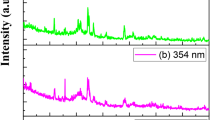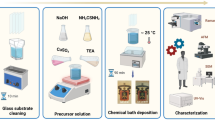Abstract
This study addresses improving the electrical properties and demonstrating the antibacterial capability of spinel ZnCo2O4 films. We used sol–gel and spin-coating techniques to prepare samples and analyzed their crystal structures, microstructures, as well as their photoelectric and antibacterial properties, in relation to Ni doping. Single-phase spinel oxide is maintained in all of the Zn(Co1-xNix)2O4 films. The replacement of cobalt by nickel causes a decrease in the average grain size and surface roughness. Both the grain size and the surface roughness affect the optical properties of the film translucence. The transmittances of all films at a wavelength of 600 nm is ~31.3–48.6%. The characteristic absorption peak of the photon-excited electron is about 400 nm. A higher doping content ratio (Nix = 0.15–0.30) causes the absorption characteristic peak to gradually disappear. The direct energy gap of all spinel oxides ranges from 2.45 to 2.57 eV. All films are p-type semiconductors, and nickel can replace cobalt to increase the carrier concentration, resulting in a decrease in the resistivity of Zn(Co1-xNix)2O4 from 312.5 Ω-cm (Nix = 0) to 15.8 Ω-cm (Nix = 0.30). The antibacterial rate for Escherichia coli and Staphylococcus aureus associated of the material can reach more than 99.9%, and no photocatalysis is necessary. Therefore, Ni-doped ZnCo2O4 possesses excellent properties for potential applications.

Highlights
-
Ni is doped in the ZnCo2O4 and influences the material characteristics.
-
Ni doping causes a decrease in the average grain size and surface roughness.
-
Ni replaces Co which enhances hole carrier concentration and conductivity.
-
A point defect mechanism formed of hole carrier of ZnCo2O4 is proposed.
-
ZnCo2O4 resist Escherichia coli and Staphylococcus aureus without photocatalysis.








Similar content being viewed by others
References
Song X, Ru Q, Mo Y, Hu S, An B (2014) A novel fiber bundle structure ZnCo2O4 as a high capacity anode material for lithium-ion battery. J Alloy Compd 606:225–219
Pan Y, Gao H, Zhang M, Li L, Wang Z (2017) Facile synthesis of ZnCo2O4 micro-flowers and micro-sheets on Ni foam for pseudocapacitor electrodes. J Alloy Compd 702:381–387
Xie Q, Zeng D, Ma Y, Lin L, Wang L, Peng DL (2015) Synthesis of ZnO–ZnCo2O4 hybrid hollow microspheres with excellent lithium storage properties. Electrochim Acta 169:283–290
Mary AJC, Bose AC (2018) Surfactant assisted ZnCo2O4 nanomaterial for supercapacitor application. Appl Surf Sci 449:105–112
Chi B, Li J, Yang X, Lin H, Wang N (2005) Electrophoretic deposition of ZnCo2O4 spinel and its electrocatalytic properties for oxygen evolution reaction. Electrochim Acta 50:2059–2064
Fu W, Li X, Zhao C, Liu Y, Zhang P, Zhou J, Pan X, Xie E (2015) Facile hydrothermal synthesis of flowerlike ZnCo2O4 microspheres as binder-free electrodes for supercapacitors. Mater Lett 149:1–4
Zhao R, Li Q, Wang C, Yin L (2016) Highly ordered mesoporous spinel ZnCo2O4 as a high-performance anode material for lithium-ion batteries. Electrochim Acta 197:58–67
Ren H, Wang W, Joo SW, Sun Y, Gu C (2019) Preparation of ZnCo2O4@reduced graphene oxide nanocomposite for high-capacity Li-ion battery anodes. Mater Res Bull 111:34–42
Dawoud H, A-Ouda L, Shaat SKK (2017) FT-IR studies of nickel substituted polycrystalline zinc spinel ferrites for structural and vibrational investigations. Chem Sci Trans 6:179–188
Dawoud H, A-Ouda L, Shaat SKK (2016) Synthetize and magnetic properties of Ni substituted polycrystalline Zn-spinel ferrites. Int J Res Appl Sci Eng Tech 4:111–118
Dawoud H, A-Ouda L, Shaat SKK (2016) Investigation of the effect of Zn ions concentration on DC conductivity and Curie temperature of Ni-spinel ferrite. Am J Mater Sci Appl 4:11–17
Jung MH (2018) The two-dimensional to three-dimensional transition structures of ZnCo2O4 for the application of lithium-ion batteries. Appl Surf Sci 427:293–301
Wang F, Liu Y, Zhao Y, Wang Y, Wang Z, Zhang W, Ren F (2018) Facile synthesis of two-dimensional porous MgCo2O4 nanosheets as anode for lithium-ion batteries. Appl Sci 8:22
Pettong T, Iamprasertkun P, Krittayavathananon A, Sukha P, Sirisinudomkit P, Seubsai A, Chareonpanich M, Kongkachuichay P, Limtrakul J, Sawangphruk M (2016) High-performance asymmetric supercapacitors of MnCo2O4 nanofibers and N-doped reduced graphene oxide aerogel. ACS Appl Mater Interfaces 8:34045–34053
Chen HY, Chen PC (2020) P-type spinel ZnCo2O4 thin films prepared using sol-gel process. Appl Surf Sci 505:144460
Yin Z, Sun Z, Wu J, Liu R, Zhang S, Qian Y, Min Y (2018) Facile synthesis of hexagonal single-crystalline ZnCo2O4 nanosheet arrays assembled by mesoporous nanosheets as electrodes for high-performance electrochemical capacitors and gas sensors. Appl Surf Sci 457:1103–1109
Chen Z, Wen XL, Niu LW, Duan M, Zhang YJ, Dong XL, Zhang RL, Chen CL (2014) Transport and magnetic properties of ZnCo2O4/Si heterostructures grown by radio frequency magnetron sputtering. Thin Solid Films 573:90–94
Kim HJ, Song IC, Sim JH, Kim H, Kim D, Ihm YE, Choo WK (2004) Structural and transport properties of cubic spinel ZnCo2O4 thin films grown by reactive magnetron sputtering. Solid State Commun 129:627–630
Liu K, Li X, Liang L, Wu J, Jiao X, Xu J, Sun Y, Xie Y (2018) Ni-doped ZnCo2O4 atomic layers to boost the selectivity in solar-driven reduction of CO2. Nano Res 11:2897–2908
Cullity BD, Stock SR (2001) Elements of X-Ray Diffraction, 3rd edn. Prentice Hall, Upper Saddle River
Zheng SY, Jiang GS, Su JR, Zhu CF (2006) The structural and electrical property of CuCr1−xNixO2 delafossite compounds. Mater Lett 60:3871–3873
Behzad H, Ghodsi FE (2016) Effect of Zn content on the structural, optical, electrical and supercapacitive properties of sol–gel derived ZnCo2O4 nanostructured thin films. J Mater Sci - Mater Electron 27:6096–6107
Wen XL, Chen Z, Liu EH, Lin X (2015) Structural and magnetic characterization of ZnCo2O4 thin film prepared by pulsed laser deposition. Appl Surf Sci 357:1212–1216
Baskey M, Maiti R, Saha SK, Chakravorty D (2014) Superior magnetic, dielectric, and magnetodielectric effects in graphene/ ZnCo2O4 nanocomposites. J Appl Phys 115:094306
Cui B, Lin H, Zhao XC, Li JB, Li WD (2011) Visible light induced photocatalytic activity of ZnCo2O4 nanoparticles. Acta Phys Chim Sin 27:2411–2415
Pankove JI (1971) Optical Processes in Semiconductors. Prentice-Hall Inc, Englewood Cliffs. NJ, p 34–57
Rao GV, Chandra GH, Reddy PS, Hussain OM, Reddy KTR, Uthanna S (2002) Influence of substrate temperature on the structural and optical properties of Cu0.5Ag0.5InSe2 films. J Optoelectron Adv Mater 4:387–392
Ramesh PP, Hussain OM, Uthanna S, Naidu BS, Reddy PJ (1998) Photovoltaic performance of p-AgInSe2/n-CdS thin film heterojunctions. Mater Lett 34:217–221
Kang Z, Yan X, Zhao L, Liao Q, Zhao K, Du H, Zhang X, Zhang X, Zhang Y (2015) Gold nanoparticle/ZnO nanorod hybrids for enhanced reactive oxygen species generation and photodynamic therapy. Nano Research 8:2004–2014
Gilani S, Ghorbanpour M, Jadid AP (2016) Antibacterial activity of ZnO films prepared by anodizing. J Nanostruct Chem 6:183–189
Pasqueta J, Chevalierb Y, Pelletierb J, Couvala E, Bouviera D, Bolzingerb MA (2014) The contribution of zinc ions to the antimicrobial activity of zinc oxide. Colloid Surf A 457:263–274
Pan L, Zhu Q, Tian D (2019) Synthesis of porous Ag/ZnCo2O4 nanosheets and their electrocatalytic, photocatalytic, and antibacterial performances. J Sol-Gel Sci Technol 90:525–534
Wei X, Chen D, Tang W (2007) Preparation and characterization of the spinel oxide ZnCo2O4 obtained by sol–gel method. Mater Chem Phys 103:54–58
Song F, Huang L, Chen D, Tang W (2008) Preparation and characterization of nanosized Zn–Co spinel oxide by solid state reaction method. Mater Lett 62:543–547
Jinlong L, Wenli G, Tongxiang L (2017) The effects of urea concentration on microstructures of ZnCo2O4 and its supercapacitor performance. Ceram Int 43:6168–6174
Mary AJC, Bose AC (2017) Hydrothermal synthesis of Mn-doped ZnCo2O4 electrode material for high-performance supercapacitor. Appl Surf Sci 425:201–211
Che H, Liu A, Zhang X, Mu J, Bai Y, Hou J (2015) Three-dimensional hierarchical ZnCo2O4 flower-like microspheres assembled from porous nanosheets: Hydrothermal synthesis and electrochemical properties. Ceram Int 41:7556–7564
Chen H, Wang J, Han X, Liao F, Zhang Y, Gao L, Xu C (2019) Facile synthesis of mesoporous ZnCo2O4 hierarchical microspheres and their excellent supercapacitor performance. Ceram Int 45:8577–8584
Liu X, Huang Y, Zhang N, Zhang Z, Yan J, Zong M, Liu P (2019) Fabrication of carbon-doped ZnCo2O4 yolk-shell microspheres compounded with magnetic graphene for enhanced electromagnetic wave absorption performance. Ceram Int 45:19720–19729
Acknowledgements
We thank the China Medical University Hospital and China Medical University for financial support for this research under contract no. ASIA-107-CMUH-10.
Author information
Authors and Affiliations
Corresponding author
Ethics declarations
Conflict of interest
The authors declare that they have no conflict of interest.
Additional information
Publisher’s note Springer Nature remains neutral with regard to jurisdictional claims in published maps and institutional affiliations.
Rights and permissions
About this article
Cite this article
Hwang, KP., Lin, HC., Su, YZ. et al. Effects of Ni doping on the structural, photoelectric, and antibacterial properties of ZnCo2O4 thin films. J Sol-Gel Sci Technol 97, 441–451 (2021). https://doi.org/10.1007/s10971-020-05406-9
Received:
Accepted:
Published:
Issue Date:
DOI: https://doi.org/10.1007/s10971-020-05406-9




